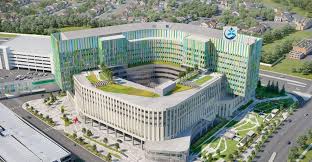Hospital construction is crucial for the city’s growth. With Calgary’s population expanding rapidly, there is an urgent need for modern healthcare facilities. As the city continues to grow, focusing on building up-to-date, efficient, and patient-centered hospitals becomes a top priority. Additionally, different climates and earthquakes all around the world demand a sustainable and robust foundation for a hospital. Thus, this blog will discuss key aspects of hospital construction in Calgary, current trends, and the importance of sustainable practices.
The Growing Need for Hospital Construction in Calgary
Calgary’s population is increasing quickly. As a result, there’s a rising demand for quality healthcare services. More people moving into the city means the existing healthcare infrastructure must expand to meet these needs. Hospital construction is not just about adding more buildings; it’s also about ensuring these buildings meet the evolving demands of the population. Additionally, there is a focus on creating environments that support the healing and well-being of every human being. Half of the patient’s healing gets cured just by being in a safe and sound environment. Therefore, the rising demand for noise-free hospitals has increased worldwide.
Embracing Modern Design and Technology
Hospitals today are more than just places for treatment; they are centers of innovation and care. Modern hospital construction emphasizes the use of the latest technology. This technology supports both healthcare providers and patients, enhancing hospital efficiency.
- Smart Rooms: Patient rooms with automatic controls for lighting, temperature, and communication to increase comfort and efficiency.
- Telemedicine: Remote consultation systems allow patients to receive care without visiting the hospital.
- Real-Time Data Monitoring: Continuous tracking of patient vital signs with instant alerts to healthcare providers for quick action.
- Robotic Assistance: Robots assist with tasks like surgery, cleaning, and delivering supplies, improving accuracy and efficiency.
- AI-Based Diagnostics: Artificial intelligence helps diagnose diseases faster and more accurately by analyzing medical data.
- Patient Tracking Systems: Real-time location systems track patients and staff, enhancing safety and resource management.
- Wearable Health Devices: Devices monitor health metrics and provide doctors with ongoing data outside the hospital.
Ensuring Safety During Earthquakes
Ensuring safety during earthquakes involves designing hospitals to withstand seismic forces. In Calgary, hospitals must have earthquake-resistant features, such as reinforced foundations and flexible shock-absorbing frames. Advanced engineering techniques, like base isolators and shock absorbers, help reduce building movement during earthquakes. Non-structural elements, including medical equipment and fixtures, are securely anchored to prevent damage. Regular safety drills and emergency plans ensure staff and patients know how to respond effectively. By focusing on these measures, Calgary hospitals can remain safe and operational during major seismic events.
Assessing the Diverse Needs of Patients
A key aspect of hospital construction in Calgary is patient-centered design. This strategy concentrates on creating spaces that promote healing and comfort. For example, natural light, quiet areas, and accessible layouts are important features. These elements are not just about looks; they directly impact patient recovery and well-being. Sky Blue values patient-centered design highly. They closely consult with healthcare providers to understand patient needs, ensuring that each hospital they build is a place where patients feel cared for and supported.
Challenges in Building a Hospital in Calgary
Building a hospital involves many challenges. Here are some of the issues faced in Calgary:
- Climate Considerations: Harsh winters and temperature swings require durable materials and construction techniques to withstand Calgary’s weather.
- Budget Constraints: Balancing high-quality construction with budget limitations is a significant challenge in large-scale hospital projects.
- Regulatory Compliance: Meeting strict health and safety regulations, building codes, and zoning laws requires careful planning and execution.
- Stakeholder Coordination: Managing the involvement of multiple stakeholders, including healthcare providers, government agencies, and contractors, can be complex and time-consuming.
- Sustainability Goals: Integrating environmentally friendly practices while keeping costs and timelines in check is both challenging and essential for modern hospital construction.
Designing for Future Health Crises in Calgary
The future of hospital construction looks promising. As technology advances, hospitals will become even more efficient and patient-friendly. There will be a greater focus on sustainability, leading to hospitals that are not only environmentally conscious but also better for those who use them. Technology like real-time data monitoring and automated systems will ensure quick responses to health threats. Strong communication systems will enhance coordination with public health authorities and the community. Visit here for a related post!
Conclusion
In sum, hospital construction in Calgary is a dynamic field that is continuously evolving. As the city grows, so does the need for innovative and sustainable healthcare facilities. Sky Blue is at the forefront of this evolution, bringing expertise, dedication, and cutting-edge solutions to every project. With a focus on technology, sustainability, and patient-centered design, such firms are helping to shape the future of healthcare in Calgary. So, start building your dreams and saving lives today! Contact Sky Blue to create a future-ready healthcare infrastructure.



Leave a Reply
View Comments